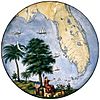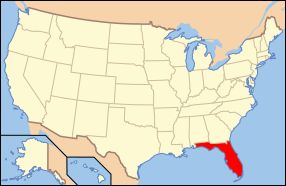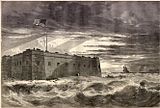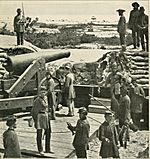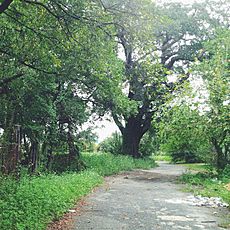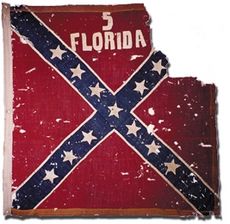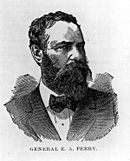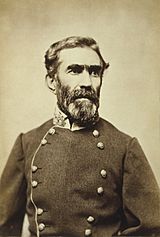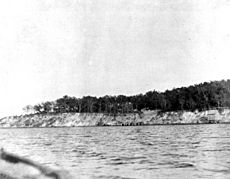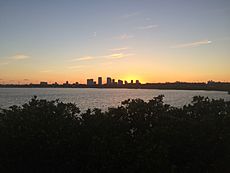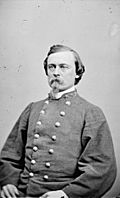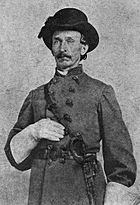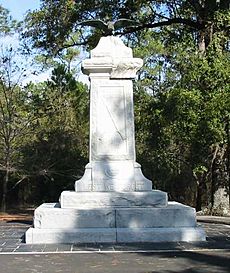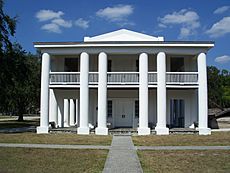Florida in the American Civil War facts for kids
Quick facts for kids Florida |
|||||
|---|---|---|---|---|---|
|
|||||
| Capital | Tallahassee | ||||
| Largest City | Pensacola | ||||
| Admission to confederacy | April 22, 1861 (7th) | ||||
| Population |
|
||||
| Forces supplied |
|
||||
| Major garrisons/armories | Fort Pickens | ||||
| Governor | Madison Perry (1861) John Milton (1861–1865) Abraham Allison (1865) |
||||
| Senators | Augustus Maxwell James Baker |
||||
| Representatives | List | ||||
| Restored to the Union | June 25, 1868 | ||||
Florida was part of the Confederate States of America during the American Civil War. It became a state in 1845, and at that time, it allowed slavery.
In January 1861, Florida decided to leave the United States. This happened after Abraham Lincoln won the presidential election in November 1860. Florida was the third Southern state to secede. It then joined six other states to form the Confederacy on February 8, 1861.
Florida had the smallest population of all the Confederate states. About 140,000 people lived there, and almost half of them were enslaved. Around 15,000 Floridians joined the Confederate army. Most of these soldiers fought in other states.
Florida was important to the Confederacy because it supplied food, especially cattle. It also had many bays and inlets that blockade-runners used to bring in supplies. These ships helped get around the Union Navy's blockade.
When the war started, the Confederate government took over many U.S. Army bases in Florida. However, the Union kept control of Key West, Fort Jefferson, and Fort Pickens. The Confederates tried to protect their farms in the middle of Florida. As the war went on, they left coastal towns and forts less protected. This allowed Union forces to take them over easily.
Most fighting in Florida was small. The biggest battle was the Battle of Olustee in February 1864. Near Lake City, a Confederate army of over 5,000 soldiers stopped a Union attack. This attack aimed to stop Florida from producing food.
During the war, many enslaved people were able to escape. Some of them became helpful to Union commanders. Soldiers who left their armies (deserters) also hid in Florida's wild areas. They sometimes attacked Confederate groups and stole from farms.
The war ended in April 1865. By the next month, the United States was back in control of Florida. Slavery was also ended. Florida officially rejoined the United States in 1868.
Contents
Florida's Early History and Growth
Florida was a Spanish territory for 300 years. It became part of the United States in 1821. At that time, most people lived in St. Augustine and Pensacola. The middle of Florida was home to the Seminoles and Black Seminoles.
Travel was hard, and Florida grew slowly. Wars to remove the Seminoles from their lands happened from the 1830s to the 1850s. This also slowed down growth. By 1840, Florida had 54,477 people. Almost half of them were African slaves.
Florida became the 27th state on March 3, 1845. It had about 66,500 people, including 30,000 enslaved people. By 1861, Florida's population grew to 140,000. About 63,000 of these were enslaved. Their forced labor produced 85 percent of the state's cotton. Most large plantations were in middle Florida, near Tallahassee.
The 1860 Election and Florida's Decision
In the 1860 U.S. presidential election, Abraham Lincoln won. However, John C. Breckinridge won in Florida. Soon after the election, people in Marion County met to demand that Florida leave the Union.
Florida's leaders decided to hold a special meeting to discuss leaving the Union. Delegates were chosen in an election and met in Tallahassee on January 3, 1861. Many of these delegates owned slaves.
Florida explained why it was leaving the Union in its Declaration of Causes for Seceding. The main reasons were about slavery. They complained that the North did not follow the Fugitive Slave Act. They also worried about people like John Brown and newspapers like The Liberator that tried to stir up slave uprisings. Lincoln's election was the final reason.
On January 7, 1861, the delegates voted to leave the Union. Sixty-two delegates voted to leave, and seven voted to stay.
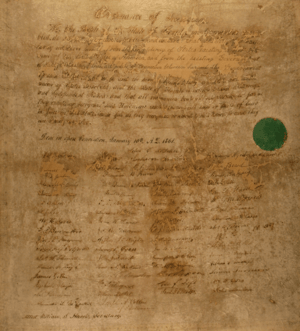
A formal document called the Ordinance of Secession was discussed. Some wanted Florida to wait for other Southern states to secede. But the vote was to leave right away. On January 10, 1861, Florida officially declared it had left the "American union." Florida was the third state to secede.
The next day, a public ceremony was held in Tallahassee. The Ordinance of Secession was signed by 69 people. People in Tallahassee celebrated with fireworks and a parade. The main reason for Florida's secession was to protect slavery.
After leaving the Union, Florida's delegates created a new state constitution. Within a month, Florida joined other Southern states to form the Confederate States of America. Florida's Senator Stephen Mallory became the Secretary of the Navy in the first Confederate government.
Florida During the Civil War
Florida's Economy and Supplies
Governor John Milton believed Florida's main role was to provide supplies, not soldiers. Florida was a big supplier of food, especially beef cattle, for the Confederate Army. However, many farmers kept growing cotton instead of food, even though officials asked them to grow food.
Florida also produced a lot of salt. Its long coastline was perfect for making salt. The U.S. Navy knew how important Florida's salt was. In 1862, they started raiding saltworks in the state.
Florida's food supply became even more important after the Siege of Vicksburg. This event split the Confederacy in half, making it hard for eastern armies to get supplies from the west. So, Florida's food helped keep the Confederate forces going.
Union Blockade of Florida
Union forces created a blockade around Florida. This was because Florida was an important supply route for the Confederate army. Florida's long coastline and many waterways made it hard for Union ships to stop all the blockade runners.
The Confederates tried to trade with Spain and Europe through Cuba. They hoped Spain would help them. But Spain tried to stay neutral and did not sell many weapons to the Confederacy. Trade that did happen, mostly through Cuba and Florida, included cotton going out and food, cigars, and medicine coming in.
Union troops took over major ports early in the war. These included Apalachicola, Cedar Key, Jacksonville, Key West, and Pensacola.
Slavery and Freedom
Most enslaved people lived in North Florida, just like most white residents. Confederate leaders used enslaved people to transport supplies and work in saltworks and fisheries. Many enslaved people working in these coastal areas escaped to Union-controlled places. Key West was a popular place to escape to because it had a large free black population and a Union army base.
The Union army also used enslaved labor. Florida was the first state to allow the government to force slave owners to lend their slaves for work. Slave owners were paid for this. Starting in 1862, Union military actions in East and West Florida encouraged more enslaved people to run away. Slave owners became more afraid of uprisings as the war continued.
Some escaped slaves worked on Union ships. Starting in 1863, over a thousand joined the United States Colored Troops (USCT) as soldiers or the Union Navy as sailors. These black soldiers helped stop Confederate cattle supplies and free other enslaved people.
In January 1865, Union General William T. Sherman issued Special Field Orders No. 15. This order set aside land in Florida for runaway and freed slaves who had followed his army. However, these orders were not fully carried out in Florida and were later canceled.
Florida's Money During the War
Florida started printing its own money in 1861. These banknotes were issued in different amounts, like $1, $2, $3, $5, $10, $20, $50, and $100.
Soldiers Leaving Their Units
Many Confederate soldiers became unhappy with the rules about joining the army and taking supplies. This led to many soldiers leaving their units (deserting). Several Florida counties became safe places for these deserters.
Groups of deserters attacked Confederate patrols, raided farms, took slaves, stole cattle, and gave information to Union forces. Some deserters and Floridians who supported the Union joined regular Federal army units.
For example, in Taylor County, a group called "The Royal Rangers" supported the United States. Even when their homes were burned, few of them gave up. Another group of deserters operated from Fort Myers. They bothered the Confederate supply chain, especially cattle.
Military Situation in Florida
Florida had about 16,000 white men who could join the army. But the state sent about 15,000 troops to the Confederacy. These soldiers were organized into twelve infantry regiments and two cavalry regiments, plus artillery units.
Florida was not very important strategically because it had a small population and not much industry. Most battles in Florida were small fights. Neither army tried hard to take full control of the state.
Seminole People During the War
In 1862, Florida tried to improve relations with the Seminole people. They wanted to stop them from fighting for the Union. But little was done to help the Seminole, and they stayed officially neutral. However, some Seminole did fight for the Confederacy, while others fought for the Union.
Forts and Military Bases
Governor Milton worked to make the state's military stronger and improve defenses. Confederate forces quickly tried to take over U.S. Army forts in Florida. They succeeded in most cases. But Fort Jefferson, Fort Pickens, and Fort Zachary Taylor stayed under Union control throughout the war.
On January 6, 1861, state troops took over the Federal arsenal in Chattahoochee. The next day, Union General Adam J. Slemmer destroyed gunpowder at Fort McRee and moved his forces to Fort Pickens.
In March 1862, Union forces captured Fort Clinch at Fernandina Beach. On March 11, the Union also captured St. Augustine and Fort Marion.
Florida's Military Units
Fighting in the East
Because Florida was not a main battleground, many of its soldiers were sent to fight in other states. The 2nd, 5th, and 8th Florida Infantries fought in the Eastern Theater with Robert E. Lee's army. They fought in major battles like Second Manassas, Antietam, Fredericksburg, Chancellorsville, and Gettysburg.
After the Battle of Antietam, these three Florida regiments were grouped together. They became known as Perry's Florida Brigade, led by Brig. Gen. Edward A. Perry.
At Fredericksburg, the 8th regiment helped protect the city. At Gettysburg, the Florida Brigade charged Cemetery Ridge twice. They lost about 60% of their soldiers in these attacks.
Fighting in the West
In early 1862, the Confederate government moved General Braxton Bragg's army from Pensacola to the Western Theater. This was because the Confederates had lost battles in Tennessee and New Orleans. The 1st and 3rd Florida Infantry Regiments joined Bragg in Tennessee. Other Florida units also fought in the Western Theater.
Battles and Skirmishes in Florida
Skirmish of the Brick Church The first land battle in Northeast Florida was the Skirmish of the Brick Church. It was a Confederate victory.
Tampa
In June 1861, the Union gunboat USS Sagamore sailed to Tampa Bay to attack Fort Brooke. The Union demanded the fort surrender, but the Confederates refused. The Sagamore then started firing at the town, and the fort fired back. This was the start of the Battle of Tampa. Neither side hit their targets directly, and no one was hurt.
St. Johns Bluff
Jacksonville was taken by Union forces after the Battle of St. Johns Bluff. This bluff was meant to stop Union ships from moving up the St. Johns River. Union troops landed and came up behind the Confederate defenses, causing the Confederates to leave.
Fort Brooke (Second Battle)
The Battle of Fort Brooke in October 1863 was the second and largest fight in Tampa. Union ships bombarded Fort Brooke. Under their cover, Union soldiers landed secretly. They marched to where two blockade-running ships were hidden and burned them. On their way back, they were attacked by Confederate cavalry and local militia. Both sides had about 20 casualties.
By May 1864, most Confederate troops had left Tampa. Union forces landed easily and destroyed supplies at Fort Brooke. They stayed for about six weeks, but then left the fort empty for the rest of the war.
Olustee
The only major battle in Florida was at Olustee, near Lake City. Union forces under General Truman Seymour were stopped by Confederate troops. The Union forces had to retreat to Jacksonville.
The Union suffered many losses at Olustee. This made people in the North question if it was worth fighting in Florida. Many Union troops were then moved out of Florida.
Horse Landing
In March 1864, the Union ship USS Columbine captured a steamboat in Palatka. Palatka was then occupied by Union troops. In May 1864, the Columbine was captured by Confederate forces led by J. J. Dickison at the "Battle of Horse Landing."
Gainesville
Confederates took over Gainesville after the Battle of Gainesville. In August 1864, Union troops left Baldwin and headed for Gainesville. They destroyed a picket post and burned Confederate train cars. Dickison's forces then attacked the Union troops from behind.
Marianna
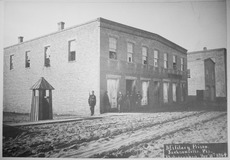
In September 1864, General Alexander Asboth led a raid on Marianna. This town was home to Governor Milton and an important supply depot. The Battle of Marianna happened, and the Union won.
Braddock's Farm Near Crescent City, the Battle of Braddock's Farm took place. Dickison's troops caught Union soldiers who had just finished a raid.
Natural Bridge
In March 1865, a small group of Confederate soldiers and volunteers stopped Union troops at the Battle of Natural Bridge. These volunteers were mostly teenagers from a military school and older men. They prevented the Union troops from crossing the Natural Bridge on the St. Marks River.
End of the War and Aftermath
On April 1, 1865, Governor Milton died. He was replaced by Abraham K. Allison.
The Florida Brigade, still with Lee's army, formally surrendered at Appomattox Court House on April 9, 1865. The war officially ended for Florida and other Southern states on April 26.
In early May 1865, Union troops came to Florida to take back control. On May 13, the last active Confederate troops in Florida surrendered.
On May 20, General Edward M. McCook read Lincoln's Emancipation Proclamation in Tallahassee. This officially ended slavery in Florida. On the same day, the U.S. flag was raised over the state capitol building.
Florida Rejoins the Union
After the war, Florida was part of the Reconstruction period. To rejoin the United States, Florida had to agree to new changes to the U.S. Constitution. These changes ended slavery and gave citizenship to former slaves.
Florida's representatives were allowed back into Congress. The state fully rejoined the United States on June 25, 1868.
Union military forces were supposed to leave Florida in July 1868. However, Governor Reed asked them to stay. Almost nine years later, as part of the Compromise of 1877, all U.S. military forces were removed from the former Confederate states, including Florida.
See also



